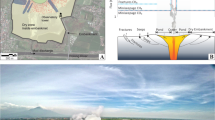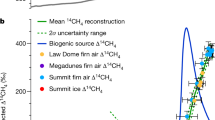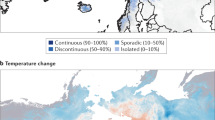Abstract
The concentration of methane (CH4) in the global troposphere is increasing. Ambient air measurements document an approximate rate of increase of 1–2% yr−1 over the past decade1–4. Measurements of CH4 in air bubbles trapped in polar ice indicate that tropospheric concentrations of CH4 several hundred years ago may have been ∼45% of present levels5–7. To understand and assess possible causes of the atmospheric CH4 increase requires improved quantitative knowledge of global sources and sinks of CH4. Previous attempts to estimate sources of atmospheric CH4, based on very few measurements, have suggested that natural and agricultural wetlands are major sources8,9. The major wetland regions of the world are in boreal, low Arctic and tropical ecosystems10. It is these regions, particularly in peatland habitats where major accumulations of organic materials occur under anaerobic conditions, that should be significant sources of global tropospheric CH4. The most extensive peatlands in the world occur in the boreal taiga zone between ∼45° and 65° N latitude. More than 95% of world peat resources occur in the Soviet Union, Canada, the United States, Sweden, Norway, Finland and the United Kingdom10. We report here the first survey of CH4 flux from northern peatlands of the United States. Emission rates ranged from 0.003 to 1.94 g CH4 m−2 day−1, with half of these values between 0.1 and 0.4 g CH4 m−2 day−1. The frequency distribution is log normal (Fig. 1) and the mean emission rate is 0.337 g CH4 m−2 day−1. Such fluxes are higher than most values reported for other ecosystems, suggesting that northern peatlands may be an important source of global tropospheric CH4.
This is a preview of subscription content, access via your institution
Access options
Subscribe to this journal
Receive 51 print issues and online access
$199.00 per year
only $3.90 per issue
Buy this article
- Purchase on Springer Link
- Instant access to full article PDF
Prices may be subject to local taxes which are calculated during checkout
Similar content being viewed by others
References
Graedel, T. E. & McRae, J. E. Geophys. Res. Lett. 7, 977–979 (1980).
Rasmussen, R. A. & Khalil, M. A. K. J. geophys. Res. 86, 883–886 (1981).
Fraser, P. J., Khalil, M. A. K., Rasmussen, R. A. & Crawford, A. J. Geophys. Res. Lett. 8, 1063–1066 (1981).
Blake, D. R. et al. Geophys. Res. Lett. 9, 477–480 (1982).
Robbins, R. C., Cavanagh, L. A. & Salas, L. J. J. geophys. Res. 78, 5341–5344 (1973).
Craig, H. & Chou, C. C. Geophys. Res. Lett. 9, 1221–1224 (1982).
Khalil, M. A. K. & Rasmussen, R. A. Chemosphere 11, 877–883 (1982).
Ehhalt, D. H. Tellus 26, 58–70 (1974).
Khalil, M. A. K. & Rasmusen, R. A. J. geophys. Res. 88, 5131–5144 (1983).
Gore, A. J. P. (ed.) Ecosystems of the World, Mires: Swamp, Bog, Fen and Moor Vols 4 A, 4 B (Elsevier, New York, 1983).
Sebacher, D. I. Rev. Scient. Instrum. 49, 1520–1525 (1978).
Sebacher, D. I. & Harriss, R. C. J. Envir. Qual. 11, 34–37 (1982).
Boelter, D. H. & Verry, E. S. USDA Forest Service Gen. Tech. Rep. NC-31 (1977).
Verry, E. S. Ecology 56, 1149–1157 (1975).
Boelter, D. H. thesis, Univ. Minnesota, Minneapolis (1962).
Joyal, R. Mich. Botan. 10, 78 (1971).
Williams, R. T. & Crawford, R. L. Appl. Envir. Microbiol. 47, 1266–1271 (1984).
Svensson, B. H. thesis, Swedish Univ. Agricultural Sciences, Uppsala (1983).
Clymo, R. S. & Reddaway, E. J. F. Hydrobiologia 12, 181–192 (1971).
Heal, O. W. & Smith, R. A. H. (eds) Production Ecology of British Moors and Montane Grasslands Ch. 1, 3–16 (Springer, Berlin 1978).
Cicerone, R. J., Shetter, J. D. & Delwiche, C. C. J. geophys. Res. 88, 11022–11024 (1983).
Seiler, E., Holzapfel-Pschorn, A. Conrad, R. & Scharffe, D. J. atmos. Chem. 1, 241–268 (1984).
Harriss, R. C. & Sebacher, D. I. Geophys. Res. Lett. 8, 1002–1004 (1981).
Miller, P. C. U.S. Dept Energy Rep. EV/10019-14, v. 2 (1982).
Verry, E. S. & Boelter, D. H. in Wetland Functions and Values: The state of Our Understanding 389–402 (American Waterworks Association, Minneapolis (1978).
Author information
Authors and Affiliations
Rights and permissions
About this article
Cite this article
Harriss, R., Gorham, E., Sebacher, D. et al. Methane flux from northern peatlands. Nature 315, 652–654 (1985). https://doi.org/10.1038/315652a0
Received:
Accepted:
Issue Date:
DOI: https://doi.org/10.1038/315652a0
This article is cited by
-
Hot moment of N2O emissions in seasonally frozen peatlands
The ISME Journal (2023)
-
The thermal response of soil microbial methanogenesis decreases in magnitude with changing temperature
Nature Communications (2020)
-
Intermittent drainage in paddy soil: ecosystem carbon budget and global warming potential
Paddy and Water Environment (2017)
-
Tropical/Subtropical Peatland Development and Global CH4 during the Last Glaciation
Scientific Reports (2016)
-
Carbon Dioxide and Methane Emissions from Mangrove-Associated Waters of the Andaman Islands, Bay of Bengal
Estuaries and Coasts (2014)
Comments
By submitting a comment you agree to abide by our Terms and Community Guidelines. If you find something abusive or that does not comply with our terms or guidelines please flag it as inappropriate.



